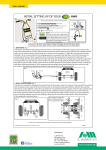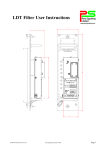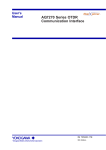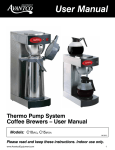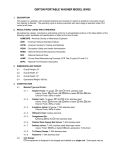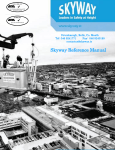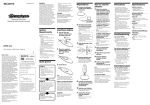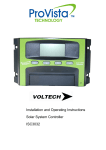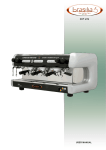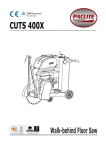Download x2 - E. Marker A/S
Transcript
Brugsanvisning FITTING THE ‘RIDE ON’ ATTACHMENT TO THE ATV (ALL TERRAIN VEHICLE) IMPORTANT: *** for the clamp screws, avoiding obvious obstructions wherever possible. Slide into position Slide the bracket onto the vehicle in the required position( forward of the seat, with the top plate of the clamp squarelyon the footplate) and hold in place. Push the unthreaded part of the screws though the holes in the bottom plate and place the clamp head (C) on the top of the screw to check that it is in a suitable position, then remove. Push the screw until the threaded part engages with the threaded hole, and turn the screw in a clockwise on the bottom plate to determine the optimum location to avoid any chassis obstacles. Use as many screws as needed, (a minimum of four) to spread the load of the clamp over the largest area possible. spring washer (A) and locking nut (B) onto the screw. Repeat this with all the screws required to secure. Replace the clamp heads and hand tighten the screws, in rotation, until all the clamp heads are touching the underside of the foot plate. A C A B B C Using a suitable 19mm ratchet spanner / wrench, gradually tighten the screws, working in a systematic pattern to avoid any possibility of 1 3 5 NOT fully tighten screws individually, to a vehicle) When the bracket is fully secured, tighten the locking nuts against the spring washers to ensure that the screws do not work loose during use. 4 2 Example of screw tightening sequence should be in a vertical position with the top plate square on the foot plate of the vehicle. It should be positioned as near as possible to the seat, allowing the operator to reach the power switch without undue stretching SEAT CLAMP IN POSITION ON VEHICLE into the foot plate, using the top plate of the bracket as a template, taking care not to compromise any chassis parts. Page 1 Distribution: E. Marker A/S Okslundvej 8, Bov DK-6330 Padborg Tlf.: +45 74 67 08 08 E-mail: [email protected] www.emarker.dk www.emarker.dk Brugsanvisning 14kg + x2 x1 CAUTION! RISK OF TRAPPING FINGERS IN MOVING PARTS, DURING ASSEMBLY fig 7 To ensure the correct working fig 6 *** Fitting the attachment is a b two person operation. Offer the attachment to the bracket, and locate up to 3 screws through the backing plate, into the slots in the bracket. Place the nuts and washers onto the screws and hand tighten until the final working position is determined. c a c fig 8 When the attachment is fitted to the required height, tighten the screws fully. When manoeuvering on the pitch or field, it is not necessary to fit the retaining pin and lynch pin, the unit will stay in the ‘UP’ position with the tension of the springs only. For moving from site to site, secure with the retaining pin d and lynch pin b to prevent accidental release of the attachment during transport. position, hand tighten the nuts a and release the lynch pin ( b fig 6 ) securing the retaining pin ( d fig 9), to allow the attachment to lower to ground level.At this level, the arms of the attachment c should be in a position lower than horizontal, as shown. if this is not the case, secure the arms again and adjust the attachment position higher on the bracket and re-tighten. FITTINGS SUPPLIED fig 9 d RETAINING PIN x1 x2 b LYNCH PIN x3 x4 30mm x M12 x5 Line width adjustment plates to adjust spray width, from 4” to 3” (75 to 100mm approx’) 120mm x M12 x5 a M12 x10 NUTS Fit in position here on both sides of spray ‘shoe’ x12 M12 WASHERS M12 x10 SPRING WASHERS Auxiliary cable (2mtrs) Pipe work extension Page 2 Distribution: E. Marker A/S Okslundvej 8, Bov DK-6330 Padborg Tlf.: +45 74 67 08 08 E-mail: [email protected] www.emarker.dk www.emarker.dk Brugsanvisning CONNECTING THE EQUIPMENT PRIOR TO SPRAYING The next stage is to make the necessary connections to allow the spraying operation to take place. STEP 1: Connect the 2 sets of cables from the spray head tube near the switch, to the extension cables. One of the cables is colour coded to avoid errors in connecting. There is an option to connect the power unit direct to the battery on the vehicle. To do this, use the auxiliary cable with the twin forked battery connectors, and connection box plug connector. Connect the cable to the battery using the forked connectors first, then plug into the connection box. Ensure the machine is turned OFF when connecting. Step 2: Connect the length of extension pipe work using the black plastic push-fit adaptor supplied. Ensure that the pipe work is inserted firmly into the adaptor and the spray head outlet on the pump. Check that all the connections are correct by turning the machine on, using the switch at the top of the spray head tube. fig 10 Spray Attachment Power Unit The spray head tube The spray head tube is complete and requires no additional assembly. It can be detached from the square tube by lifting upwards slightly to clear the height stop B, and pulling forward out of the plastic clips A. This will be useful when marking penalty spots and corner quadrants. A Do not over-reach with the tube causing electrical connections to dislodge or become damaged. To prevent this problem if used A regularly, detach the B switch cable from the other cables, and refasten the remaining cables. SPRAYING PAINT AND CLEANING THE RIDE ON EQUIPMENT THE ATTACHMENT SHOULD BE IN THE FULLY DOWN POSITION WHEN THE SPRAYING OPERATION COMMENCES Paint Filter fig 11 FROM THE PAINT CONTAINER TO THE SPRAYHEAD BATTERY COVER Position 1 1 Position 2 No Filter FROM THE WATER CONTAINER + PUMP Spraying Paint: To spray paint through the system, it is important to ensure that the valve tap 1 is in the correct position to draw the paint from the container. The paint probe is fitted with a filter, and should not be used for the water delivery at this stage. The valve tap should be positioned so that it is in line with the paint tube as shown in fig 11 position 1. Switch on the machine using the switch on the top of the attachment, to start the paint flow. As soon as the paint flows freely from the spray head, spraying can begin. At any time during the spraying operation, the flow can be stopped or started using the switch. To avoid any drying out of paint on the nozzle during hot or warm weather, when moving from one pitch / field to another pitch / field, move the valve tap to position 2 and turn the switch on, to allow water to flush through the spray nozzle. Then return to position 1 to return to spraying paint. Cleaning the Ride On: To thoroughly clean the Ride On at the end of the day, place the paint delivery probe into the water container, and turn on the machine. This will allow water to clean the paint probe and filter, the pump and the spray head. Only perform this operation in an area which will not be affected by the paint in the system that will be discharged onto the ground. Run water through the system until the spray from the nozzle is clear, or evident that the system has been cleaned. Replace the cap on the paint container to avoid any spillage during the transporting of the vehicle back to the storage area. (When familiar with the machines performance, it is possible to move the paint probe to the water container, turning the valve tap to position 2, before completing the last part of the marking out operation. This will use the paint already in the system to complete the marking, before water starts to be dispensed through the spray nozzle. Experience will determine the distance that can be covered by the remaining paint) Page 3 Distribution: E. Marker A/S Okslundvej 8, Bov DK-6330 Padborg Tlf.: +45 74 67 08 08 E-mail: [email protected] www.emarker.dk www.emarker.dk



